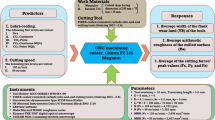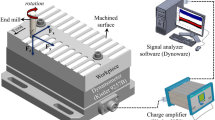Abstract
Mechanical components applied in ore crushing, the drilling of oil wells, and soil plowing need to be manufactured from materials with high resistance to abrasive wear, erosion, and corrosion. Typical materials applied under these severe conditions are cold work tool steels, high-speed steels and high-Cr white cast iron (HCWCI), which present a challenge in machining. In milling, the cutting fluid can easily access the cutting region due to interrupted cutting. In this context, coated cemented carbides associated with lubri-cooling techniques may be an alternative to improve the process feasibility. The aim of this study was to evaluate the effects of different coated cemented carbide grades and lubri-cooling techniques on the tool life and surface residual stress of the milled surface of HCWCI. Therefore, two coated cemented carbide grades associated with two lubri-cooling techniques (flood emulsion and liquid nitrogen—LN2) were applied in milling tests. The results demonstrated the feasibility of using the coated cemented carbide as a tool material in the milling of HCWCI (cutting time longer than 15 min). Furthermore, LN2 increased, by at least a factor of 2, the tool life when compared with flood emulsion. Regarding the milled surface, values above 500 MPa were obtained for the compressive residual stresses with the use of the worn cutting edges and the application of LN2.








Similar content being viewed by others
References
Gutnichenko O, Bushlya V, Zhou J, Ståhl JE (2017) Tool wear and machining dynamics when turning high chromium white cast iron with pcBN tools. Wear 390–391:253–269. https://doi.org/10.1016/j.wear.2017.08.005
Berns H, Theisen W (2008) Ferrous materials, 1st edn. Springer, Leipzig
Laird G, Gundlach R, Rohrig K (2015) Abrasion-resistant cast iron handbook, 1st edn. American Foundry Society, Schaumburg
Shaw BA, Aylott C, O’Hara P, Brimble K (2003) The role of residual stress on the fatigue strength of high performance gearing. Int J Fatigue 25:1279–1283. https://doi.org/10.1016/j.ijfatigue.2003.08.014
Lesyk DA, Martinez S, Dzhemelinskyy VV et al (2015) Surface microrelief and hardness of laser hardened and ultrasonically peened AISI D2 tool steel. Surf Coat Technol 278:108–120. https://doi.org/10.1016/j.surfcoat.2015.07.049
Ghanem F, Braham C, Fitzpatrick ME, Sidhom H (2002) Effect of near-surface residual stress and microstructure modification from machining on the fatigue endurance of a tool steel. J Mater Eng Perform 11:631–639. https://doi.org/10.1361/105994902770343629
Leadebal WV Jr, de Melo ACA, de Oliveira AJ, Castro NA (2018) Effects of cryogenic cooling on the surface integrity in hard turning of AISI D6 steel. J Braz Soc Mech Sci Eng 40. https://doi.org/10.1007/s40430-017-0922-6
ISO (2002) ISO1302: Geometrical Product Specifications (GPS) -- Indication of surface texture in technical product documentation. In: 54
de Oliveira AJ, Boing D, Schroeter RB (2016) Effect of PCBN tool grade and cutting type on hard turning of high-chromium white cast iron. Int J Adv Manuf Technol 82:797–807. https://doi.org/10.1007/s00170-015-7426-2
Chen L, Zhou J, Bushlya V et al (2015) Performance assessment of pCBN and bCBN tools in machining of high-chromium white cast iron. Int J Adv Manuf Technol 79:635–644. https://doi.org/10.1007/s00170-015-6863-2
Li JG, Wang SQ (2017) Distortion caused by residual stresses in machining aeronautical aluminum alloy parts: recent advances. Int J Adv Manuf Technol 89:997–1012. https://doi.org/10.1007/s00170-016-9066-6
Coromant S (2015) Rotating Tools Catalogue, 1st edn. Sandvik Coromant, Stockholm
Boing D, de Oliveira AJ, Schroeter RB (2018) Limiting conditions for application of PVD (TiAlN) and CVD (TiCN/Al2O3/TiN) coated cemented carbide grades in the turning of hardened steels. Wear 416–417:54–61. https://doi.org/10.1016/j.wear.2018.10.007
Girelli L, Pola A, Gelfi M et al (2017) Performance optimization of high resistant white cast iron for severe working applications. Metall Ital 109:5–10
Ravi S, Kumar MP (2012) Experimental investigation of cryogenic cooling in milling of AISI D3 tool steel. Mater Manuf Process 27:1017–1021. https://doi.org/10.1080/10426914.2011.654157
Astakhov VP (2006) Tribology of metal cutting, 1st edn. Elsevier, Amsterdam
Lii DF (1998) The effects of aluminium composition on the mechanical properties of reactivity sputtered TiAlN films. J Mater Sci 33:2137–2145. https://doi.org/10.1023/A:1004327421261
Boing D, de Oliveira AJ, Schroeter RB (2020) Evaluation of wear mechanisms of PVD and CVD coatings deposited on cemented carbide substrates applied to hard turning. Int J Adv Manuf Technol 106:5441–5451. https://doi.org/10.1007/s00170-020-05000-x
Gassner M, Schalk N, Tkadletz M et al (2019) Thermal crack network on CVD TiCN/α-Al 2 O 3 coated cemented carbide cutting tools. Int J Refract Met Hard Mater 81:1–6. https://doi.org/10.1016/j.ijrmhm.2019.02.006
Shen Q, Liu Z, Hua Y et al (2018) Effects of cutting edge microgeometry on residual stress in orthogonal cutting of inconel 718 by FEM. Materials (Basel) 11. https://doi.org/10.3390/ma11061015
Acknowledgments
The authors would like to acknowledge a scholarship provided by CAPES (Coordination for the Improvement of Higher Education Personnel) in Brazil.
Author information
Authors and Affiliations
Corresponding author
Additional information
Publisher’s note
Springer Nature remains neutral with regard to jurisdictional claims in published maps and institutional affiliations.
Rights and permissions
About this article
Cite this article
de Oliveira, A.J., de Araújo Oliveira, M.V., de Melo, A.C.A. et al. Effects of different tool material grades and lubri-cooling techniques in milling of high-Cr white cast iron. Int J Adv Manuf Technol 110, 875–886 (2020). https://doi.org/10.1007/s00170-020-05910-w
Received:
Accepted:
Published:
Issue Date:
DOI: https://doi.org/10.1007/s00170-020-05910-w




